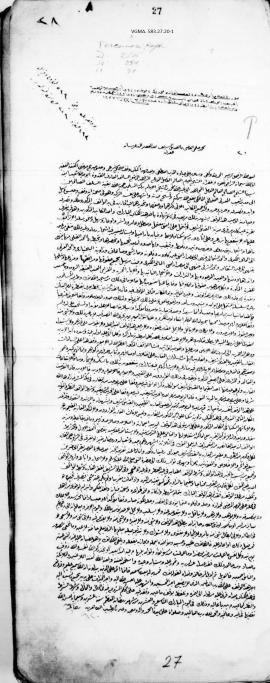Identity area
Reference code
Title
Date(s)
- 1303-10-15-1914-09-28 (Creation)
Level of description
Collection
Extent and medium
Global extent: 610 ʿatīḳ (old) appointment and cedīd (new) registers; 79 selected and described items
Context area
Name of creator
Administrative history
In Jerusalem, there was a Directorate of Awqâf (Awqaf Müdiriyeti) for the late Ottoman period, namely after Tanzimat (promulgated in 1839). But the Ministry of Awqâf in Istanbul was established in 1826. This application implemented by the central authority was also followed by the local administrations. Then, for the British Mandate and Jordanian periods there were two divisions in Awqâf administration : one was the General Directorate of Awqâf and the other was the Jerusalem Awqâf Administration.
The Department of the Waqf in Jerusalem charged with handling the question of Waqf properties was founded in 1264 H/1845 CE.
In the British Mandatory period these official functions were taken on by a specially created body known as the Supreme Muslim Council. After 1948, the SMC was replaced by the Jordanian government with a body that became known as the Awqaf Administration.
Archival history
Immediate source of acquisition or transfer
Content and structure area
Scope and content
This body of document is composed of registers from the records of the awqāf of the Maghariba neighborhood. They mainly deal with appointments, promotions, and dismissals of waqf employees.
The appointment registers (esās/şaẖsiyāt) are an other primary sources to provide us with adequate information on the actual nature of the social and economic activities of a waqf, or on the changes in these activities over time.
The registers are bound in leather, cloth, or marbled paper, and are written in the inaccessible ṣiyaḳat writing style [...]. Ṣiyaḳat refers to letters and numbers expressed in the “stairs” style of writing, used in Ottoman accounting documents to establish a powerful regime of surveillance, inspection, and communication. Each register starts with an index page. In the index, the records are organized under the headings of the district names and the records were entered on this basis. Records are usually written vertically. The contents provide detailed information about the administrative structure of the area, the names of the district, names of the awqāf and their founders, types of work, previous and current names of office holders, reasons for new postings, fees, names of administrators who can request different postings, and the dates of documents recorded in a specific order and sequence.
While the records in the ʿatīḳ registers are arranged according to their administrative units, the cedīd structure is identical to the waqf registers. These registers began to be kept after 1300/1882, with a specific reference to the ʿatīḳ series. These are also hardcover volumes bound in leather, cloth, or marbled
paper, written in rikʿa, rikʿa crumble, dīvanī or tāʿlīk style. The records are usually written horizontally. Four series of registers make up this collection. The cedīd registers are also organized differently than the ʿatīḳ registers and are written in a systematic way in a chart called the “Register of Professions” (Defter Esās Cihāt). All new appointments and other additions are written in the events section of the chart. Thus, this chart acts as a summary of the activities of the waqfiyya.
The records of the Maghariba neighborhood are located in number 515 of the ʿatīḳ registers (Kudüs ʿatīḳ) and in number 160 of the cedīd (Kudüs cedīd) registers. There is also an index register numbered 163 called the Index of Benghazi and Jerusalem, which includes the index of the ʿatīḳ and cedīd registers.
Appraisal, destruction and scheduling
Accruals
System of arrangement
Conditions of access and use area
Conditions governing access
Subject to the authorization of the Archive of the General Directorate of Foundations, Ankara (VGMA)
Conditions governing reproduction
Language of material
Script of material
Language and script notes
Physical characteristics and technical requirements
Finding aids
Allied materials area
Existence and location of originals
Existence and location of copies
Related units of description
Notes area
Alternative identifier(s)
Access points
Subject access points
Place access points
Name access points
Genre access points
Description control area
Description identifier
Institution identifier
Rules and/or conventions used
ISAD(G), Second Edition, Ottawa 2000.
Status
Level of detail
Dates of creation revision deletion
Catalogue prepared on June 2016; revised on September 2019
Language(s)
Script(s)
Sources
Şerife Eroğlu Memiş, “Appointment Registers as Archival Sources for Waqf Studies between Ottomanization and Local Networks: The Case of the Waqfs of Magharibah Neighborhood”, Proceedings of Open Jerusalem International Symposium “Revealing Ordinary Jerusalem (1840-1940), New Archives and Perspectives on Urban Citizenship and Global Entanglements” (ERC, Forth), Institute for Mediterranean Studies, Rethymno, Greece, May 2016, forthcoming.
Archivist's note
Inventory of a selection of 79 items from appointment registers from the records of the awqāf of the Maghariba neighborhood (1303-1914), held by the Archive of the General Directorate of Foundations (Ankara), made and translated by Şerife Eroğlu Memiş, June 2016.

